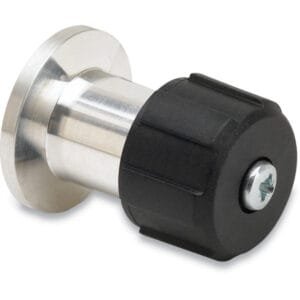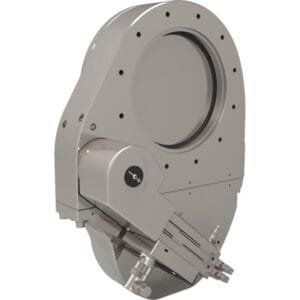Vented Stainless Steel Bolts (SI)
TFM offers premium Vented Stainless Steel Bolts (SI) engineered for use in high-vacuum and ultra-high-vacuum (UHV) environments. These bolts are manufactured with a precision axial vent hole that allows trapped gases to escape from blind holes, minimizing virtual leaks and significantly improving pump-down times.
Key Features
Axially Vented Design
The central vent hole enables the efficient release of trapped gases, preventing virtual leaks and reducing outgassing in vacuum systems.High-Quality Stainless Steel
Made from robust and corrosion-resistant 18-8 stainless steel or 304/316 grades, suitable for demanding scientific and industrial environments.Silver Inch (SI) Threading
These bolts follow the inch-based thread standard with high precision, compatible with a wide range of UHV flanges and vacuum components.Cleanroom Ready
Every bolt is ultrasonically cleaned, vacuum-packed, and double-bagged, ensuring suitability for immediate use in cleanrooms and contamination-sensitive systems.Custom Options Available
TFM can provide various head styles, lengths, and coatings such as silver or MoS₂ for galling prevention and enhanced performance.
Applications
UHV and high-vacuum systems
Semiconductor and electronics manufacturing
Surface science and thin film deposition systems
Aerospace, cryogenics, and satellite technologies
Analytical instruments and research-grade chambers
Why Choose TFM?
TFM’s Vented Stainless Steel Bolts (SI) are trusted by vacuum engineers, researchers, and manufacturers worldwide for their reliability, cleanliness, and precision. Whether you’re upgrading a vacuum chamber or building a new system, these bolts provide the performance you need.
Dimensional Drawings
Ordering Table
| Reference | Length | Material | Thread Size | Part Number |
| Screw, Cap Hardware, No Finish, Vented | 0.13 | SST | #2-56 | HCHU0256-013S40V |
| Screw, Cap Hardware, No Finish, Vented | 0.31 | SST | #2-56 | HCHU0256-031S40V |
| Screw, Cap Hardware, No Finish, Vented | 0.5 | SST | #2-56 | HCHU0256-050S40V |
| Screw, Cap Hardware, No Finish, Vented | 0.13 | SST | #4-40 | HCHU0440-013S40V |
| Screw, Cap Hardware, No Finish, Vented | 0.31 | SST | #4-40 | HCHU0440-031S40V |
| Screw, Cap Hardware, No Finish, Vented | 0.5 | SST | #4-40 | HCHU0440-050S40V |
| Screw, Cap Hardware, No Finish, Vented | 0.88 | SST | #4-40 | HCHU0440-088S40V |
| Screw, Cap Hardware, No Finish, Vented | 0.13 | SST | #6-32 | HCHU0632-013S40V |
| Screw, Cap Hardware, No Finish, Vented | 0.31 | SST | #6-32 | HCHU0632-031S40V |
| Screw, Cap Hardware, No Finish, Vented | 0.5 | SST | #6-32 | HCHU0632-050S40V |
| Screw, Cap Hardware, No Finish, Vented | 0.75 | SST | #6-32 | HCHU0632-075S40V |
| Screw, Cap Hardware, No Finish, Vented | 0.19 | SST | #8-32 | HCHU0832-018S40V |
| Screw, Cap Hardware, No Finish, Vented | 0.38 | SST | #8-32 | HCHU0832-038S40V |
| Screw, Cap Hardware, No Finish, Vented | 0.56 | SST | #8-32 | HCHU0832-056S40V |
| Screw, Cap Hardware, No Finish, Vented | 0.88 | SST | #8-32 | HCHU0832-088S40V |
| Screw, Cap Hardware, No Finish, Vented | 1.25 | SST | #8-32 | HCHU0832-125S40V |
| Screw, Cap Hardware, No Finish, Vented | 0.38 | SST | #10-32 | HCHU1032-038S40V |
| Screw, Cap Hardware, No Finish, Vented | 0.56 | SST | #10-32 | HCHU1032-056S40V |
| Screw, Cap Hardware, No Finish, Vented | 0.75 | SST | #10-32 | HCHU1032-075S40V |
| Screw, Cap Hardware, No Finish, Vented | 1.5 | SST | #10-32 | HCHU1032-150S40V |
| Screw, Cap Hardware, No Finish, Vented | 0.88 | SST | 1/4-28 | HCHU2528-088S40V |
| Screw, Cap Hardware, No Finish, Vented | 0.5 | SST | 5/16-24 | HCHU3124-050S40V |
| Screw, Cap Hardware, No Finish, Vented | 1.25 | SST | 5/16-24 | HCHU3124-125S40V |





Reviews
There are no reviews yet.